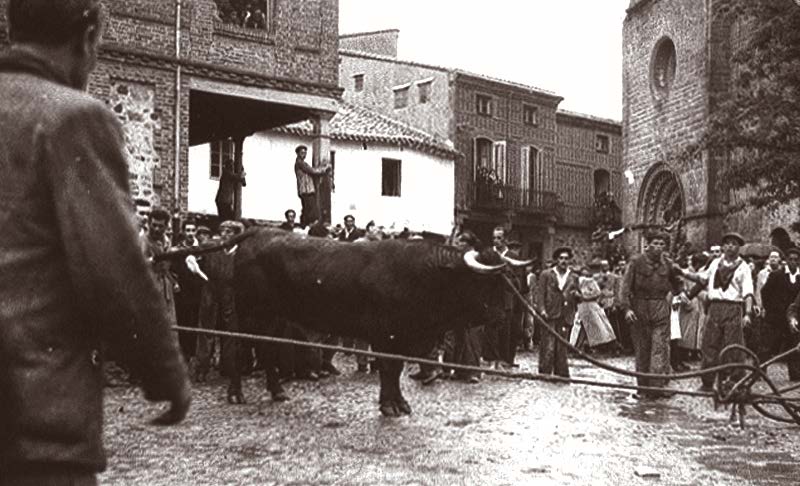The feast of the bull rope, enmaromado or ensogado, is one more link in the long chain of rites and festivals, in a country where the figure of the bull has always been understood from a perspective and conception magical-religious. It is well known that there are certain issues and attitudes in life which performed a repeated routine, look, lose the load of occult symbolism that usually precedes them. Something like this may have occurred with this type of celebrations. In such a way that appreciate the connections or reflections of the ancient rites that had the symbol of the bull. So recently, signs, and parallels with the ancient rites táuricos, including the request by the people, and subsequent choice of animal, its brought in from the pasture and its desenjaule, driving by a preset schedule, your journey and sacrifice, etc pagan Rituals that by religious syncretism were adopted and modified with the introduction of christianity. It is not surprising therefore that many of these festivities to coincide with some of the major celebrations of christianity.
The celebrations of the bulls, rope, ensogados or enmaromados had in the Iberian Peninsula a high level of acceptance and expansion during the Middle Ages. This is reflected in documents provincial as of Tudela, also called Sobrarbe (s. XII), the Jurisdiction of Albarracín (s. XIII), in various medieval chronicles and other relevant documents such as the Cantigas of Alfonso X “The Wise” (s. XIII). Some authors and historians of the art of bullfighting glimpsed a remote source of the popular festivals celebrated in activities hunting of the ancient hispanic cultures. Such is the case of authors, aristocrats understood in bullfighting, as Juan Gualberto López-Valdemoro (Conde de las Navas), José María Palace and Abárzuza, (Conde de Las Almenas), Bernardino de Melgar and Abreu. (Marqués de San Juan de Piedras Albas). Other renowned authors focus their origin in ancient rituals with sacrificial gifts as Pedro Romero de Solis, Manuel Delgado or Julian Pitt-Rivers. The ethnographer and anthropologist Julio Caro Baroja sets the source of the bulls enmaromados or rope in the context of the family parties. These parties, in which they ran bulls ensogados is used to celebrate for different reasons: to celebrate visits of kings or great personages, ordinations of priests, births, baptisms, weddings, betrothal and marriage. This theory is shared by Pedro Álvarez de Miranda, who stood to the bulls enmaromados as one of the variants of the so-called “bulls bridal”which took place on the occasion of the ritual and celebration some weddings meant. Custom this which in other times was extended over large parts of Spain. He argues that this type of celebrations from rituals associated with the cult of fertility and fertility, in which man was intended to seize power genésico del toro.

The running bulls ensogados was a common practice to celebrate the first mass of the priests, and hence is derived the name of "Bulls Misacantanos". Another custom very widespread in the FOURTEENTH and FIFTEENTH centuries to celebrate holiday votives or votes in patron saints of a place or by a guild or brotherhood of the bulls ensogados. A custom which would last during the following centuries in many places of the peninsula, and that has survived in a few places. In the absence of a source for certain of these lots popular we attend to the work of Francisco J. Flowers Rill (“Running of the bulls in Spain – From the mountain to the square”), who as a logical hypothesis states the possible root of the same in the transfer as a hunter since the prehistoric man was carried out of the bulls primitive or uros, for which it should be served between other elements and techniques of the use of ropes or cordage in order to control them and lead them to secure rooms. During the same would be carried out racing, lunges, and other issues that would provide risk and fun to the locals. It was common in the SIXTEENTH and SEVENTEENTH centuries in all the cities and villages of the kingdom, which given the extraordinary love of all the luck and games bullfighting, and as a result of any pretext or a public holiday or simply on the occasion of the arrival from the meadows of wild cattle that were brought to the slaughterhouse to fill the supply of meat, the young men of the place ejercitasen all kinds of shows and entertainments in the bullfighting arena. The same Flowers Rill, in his work: "The bull in antiquity: animal worship, sacrifice, and hunting party", looks at this appearance: "the bulls run through the streets of the towns on the so-called bulls (...) had their origin, as the bull ensogado, in the brought of the bulls of the mountains, and pastures to the villages, although here, the presence of the bull free is telling us in good part, that we are in a ritual feast fit for a city that comes to remember when they came to her bulls that had been conducted by the cowboys, and pastors through fields and numerous conference (...) This was the common way of driving the toradas, which meant that in many towns there were pens conditioned on the outskirts, to serve as guard and protection until they were way or, lastly, were being led to the slaughter, or toriles of the square to be run on the feast days that were enchiquerados waiting for the time to come out to the coso".

Do you like it? Go click and share!